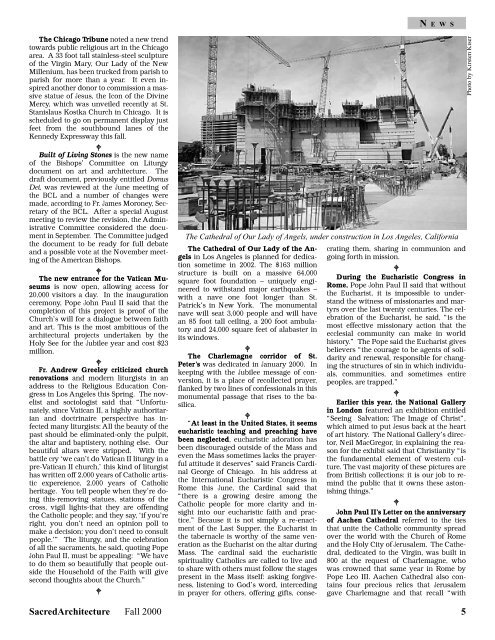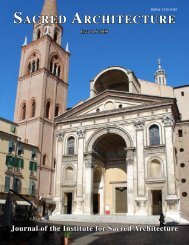Download Issue PDF - The Institute for Sacred Architecture
Download Issue PDF - The Institute for Sacred Architecture
Download Issue PDF - The Institute for Sacred Architecture
- No tags were found...
Create successful ePaper yourself
Turn your PDF publications into a flip-book with our unique Google optimized e-Paper software.
N E W S<strong>The</strong> Chicago Tribune noted a new trendtowards public religious art in the Chicagoarea. A 33 foot tall stainless-steel sculptureof the Virgin Mary, Our Lady of the NewMillenium, has been trucked from parish toparish <strong>for</strong> more than a year. It even inspiredanother donor to commission a massivestatue of Jesus, the Icon of the DivineMercy, which was unveiled recently at St.Stanislaus Kostka Church in Chicago. It isscheduled to go on permanent display justfeet from the southbound lanes of theKennedy Expressway this fall.Built of Living Stones is the new nameof the Bishops’ Committee on Liturgydocument on art and architecture. <strong>The</strong>draft document, previously entitled DomusDei, was reviewed at the June meeting ofthe BCL and a number of changes weremade, according to Fr. James Moroney, Secretaryof the BCL. After a special Augustmeeting to review the revision, the AdministrativeCommittee considered the documentin September. <strong>The</strong> Committee judgedthe document to be ready <strong>for</strong> full debateand a possible vote at the November meetingof the American Bishops.<strong>The</strong> new entrance <strong>for</strong> the Vatican Museumsis now open, allowing access <strong>for</strong>20,000 visitors a day. In the inaugurationceremony, Pope John Paul II said that thecompletion of this project is proof of theChurch’s will <strong>for</strong> a dialogue between faithand art. This is the most ambitious of thearchitectural projects undertaken by theHoly See <strong>for</strong> the Jubilee year and cost $23million.Fr. Andrew Greeley criticized churchrenovations and modern liturgists in anaddress to the Religious Education Congressin Los Angeles this Spring. <strong>The</strong> novelistand sociologist said that “Un<strong>for</strong>tunately,since Vatican II, a highly authoritarianand doctrinaire perspective has infectedmany liturgists: All the beauty of thepast should be eliminated-only the pulpit,the altar and baptistery, nothing else. Ourbeautiful altars were stripped. With thebattle cry ‘we can’t do Vatican II liturgy in apre-Vatican II church,’ this kind of liturgisthas written off 2,000 years of Catholic artisticexpereience, 2,000 years of Catholicheritage. You tell people when they’re doingthis-removing statues, stations of thecross, vigil lights-that they are offendingthe Catholic people; and they say, ‘if you’reright, you don’t need an opinion poll tomake a decision; you don’t need to consultpeople.’” <strong>The</strong> liturgy, and the celebrationof all the sacraments, he said, quoting PopeJohn Paul II, must be appealing: “We haveto do them so beautifully that people outsidethe Household of the Faith will givesecond thoughts about the Church.”<strong>The</strong> Cathedral of Our Lady of Angels, under construction in Los Angeles, Cali<strong>for</strong>nia<strong>The</strong> Cathedral of Our Lady of the Angelsin Los Angeles is planned <strong>for</strong> dedicationsometime in 2002. <strong>The</strong> $163 millionstructure is built on a massive 64,000square foot foundation – uniquely engineeredto withstand major earthquakes –with a nave one foot longer than St.Patrick’s in New York. <strong>The</strong> monumentalnave will seat 3,000 people and will havean 85 foot tall ceiling, a 200 foot ambulatoryand 24,000 square feet of alabaster inits windows.<strong>The</strong> Charlemagne corridor of St.Peter’s was dedicated in January 2000. Inkeeping with the Jubilee message of conversion,it is a place of recollected prayer,flanked by two lines of confessionals in thismonumental passage that rises to the basilica.“At least in the United States, it seemseucharistic teaching and preaching havebeen neglected, eucharistic adoration hasbeen discouraged outside of the Mass andeven the Mass sometimes lacks the prayerfulattitude it deserves” said Francis CardinalGeorge of Chicago. In his address atthe International Eucharistic Congress inRome this June, the Cardinal said that“there is a growing desire among theCatholic people <strong>for</strong> more clarity and insightinto our eucharistic faith and practice.”Because it is not simply a re-enactmentof the Last Supper, the Eucharist inthe tabernacle is worthy of the same venerationas the Eucharist on the altar duringMass. <strong>The</strong> cardinal said the eucharisticspirituality Catholics are called to live andto share with others must follow the stagespresent in the Mass itself: asking <strong>for</strong>giveness,listening to God’s word, intercedingin prayer <strong>for</strong> others, offering gifts, consecratingthem, sharing in communion andgoing <strong>for</strong>th in mission.During the Eucharistic Congress inRome, Pope John Paul II said that withoutthe Eucharist, it is impossible to understandthe witness of missionaries and martyrsover the last twenty centuries. <strong>The</strong> celebrationof the Eucharist, he said, “is themost effective missionary action that theecclesial community can make in worldhistory.” <strong>The</strong> Pope said the Eucharist givesbelievers “the courage to be agents of solidarityand renewal, responsible <strong>for</strong> changingthe structures of sin in which individuals,communities, and sometimes entirepeoples, are trapped.”Earlier this year, the National Galleryin London featured an exhibition entitled“Seeing Salvation: <strong>The</strong> Image of Christ”,which aimed to put Jesus back at the heartof art history. <strong>The</strong> National Gallery’s director,Neil MacGregor, in explaining the reason<strong>for</strong> the exhibit said that Christianity “isthe fundamental element of western culture.<strong>The</strong> vast majority of these pictures arefrom British collections: it is our job to remindthe public that it owns these astonishingthings.”John Paul II’s Letter on the anniversaryof Aachen Cathedral referred to the tiesthat unite the Catholic community spreadover the world with the Church of Romeand the Holy City of Jerusalem. <strong>The</strong> Cathedral,dedicated to the Virgin, was built in800 at the request of Charlemagne, whowas crowned that same year in Rome byPope Leo III. Aachen Cathedral also containsfour precious relics that Jerusalemgave Charlemagne and that recall “withPhoto by Kirsten Kiser<strong>Sacred</strong><strong>Architecture</strong> Fall 2000 5










